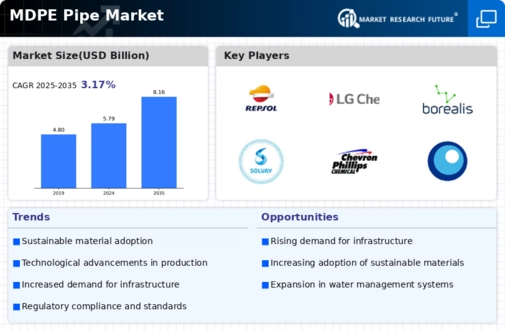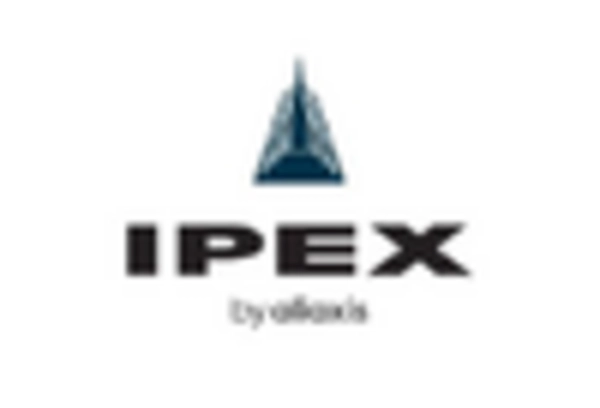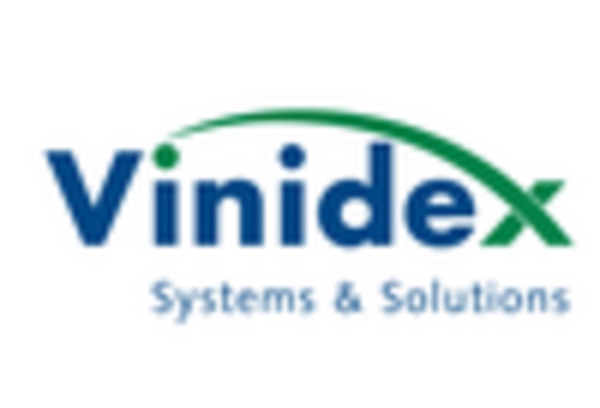Environmental Regulations
Increasing environmental regulations are shaping the MDPE Pipe Market by promoting the use of eco-friendly materials. Governments are implementing stringent policies aimed at reducing carbon footprints and enhancing sustainability in construction practices. MDPE pipes, known for their low environmental impact and recyclability, are becoming a preferred choice for many projects. In 2025, the market may see a notable increase in demand as companies strive to comply with these regulations. The adoption of MDPE pipes aligns with the global shift towards sustainable practices, potentially leading to a market growth rate of around 6% in the coming years. This regulatory landscape encourages innovation and the development of more sustainable piping solutions, further solidifying the position of MDPE pipes in the industry.
Technological Innovations
Technological advancements are playing a pivotal role in shaping the MDPE Pipe Market. Innovations in manufacturing processes and materials science are leading to the development of enhanced MDPE pipes with improved performance characteristics. These advancements include better resistance to pressure and temperature fluctuations, which are critical for various applications. In 2025, the market is likely to benefit from these innovations, with a projected growth rate of approximately 5% as companies adopt new technologies to enhance product offerings. The integration of smart technologies in piping systems is also emerging, allowing for better monitoring and maintenance. This trend not only improves the efficiency of MDPE pipes but also positions them as a forward-thinking solution in the industry.
Infrastructure Development
The ongoing expansion of infrastructure projects across various sectors is a primary driver for the MDPE Pipe Market. Governments and private entities are investing heavily in water supply, sewage systems, and gas distribution networks. For instance, the demand for MDPE pipes is projected to grow as municipalities upgrade aging infrastructure to meet modern standards. In 2025, the market is expected to witness a surge in demand, with estimates suggesting a growth rate of approximately 5% annually. This trend indicates a robust need for durable and reliable piping solutions, which MDPE pipes provide due to their resistance to corrosion and flexibility. As urbanization continues to rise, the MDPE Pipe Market is likely to benefit significantly from these infrastructure initiatives.
Growing Natural Gas Distribution
The increasing reliance on natural gas as a cleaner energy source is significantly influencing the MDPE Pipe Market. As countries transition towards more sustainable energy solutions, the demand for MDPE pipes in natural gas distribution networks is expected to rise. These pipes are particularly suited for gas applications due to their resistance to stress and environmental factors. In 2025, the market may witness a growth rate of around 6% in the natural gas sector, driven by the expansion of gas infrastructure. This trend highlights the critical role of MDPE pipes in facilitating the safe and efficient distribution of natural gas, thereby enhancing their market viability. The shift towards natural gas not only supports energy diversification but also reinforces the importance of MDPE pipes in modern energy systems.
Rising Demand for Water Supply Systems
The escalating demand for efficient water supply systems is a crucial driver for the MDPE Pipe Market. As populations grow and urban areas expand, the need for reliable water distribution networks intensifies. MDPE pipes are favored for their lightweight nature and ease of installation, making them ideal for new water supply projects. In 2025, the market is projected to experience a significant uptick in demand, with estimates indicating a potential increase of 7% in the water supply sector alone. This trend underscores the importance of MDPE pipes in ensuring safe and efficient water delivery, thereby enhancing their market presence. The ability of MDPE pipes to withstand varying environmental conditions further contributes to their growing popularity in water infrastructure.


















Leave a Comment